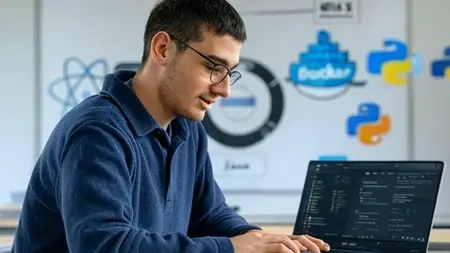Containers & Kubernetes From Scratch: Hands-On Lab-Based
Published 3/2025
MP4 | Video: h264, 1920x1080 | Audio: AAC, 44.1 KHz
Language: English | Size: 18.15 GB | Duration: 15h 33m
Published 3/2025
MP4 | Video: h264, 1920x1080 | Audio: AAC, 44.1 KHz
Language: English | Size: 18.15 GB | Duration: 15h 33m
Master Containers, Docker, and Kubernetes step-by-step with real-world projects and hands-on labs.
What you'll learn
Understand Software, Web Applications & Microservices – Learn the basics of modern applications before diving into DevOps.
Deploy a Real-World Microservices App – Work with React (frontend), Java (backend), and Python (backend) on AWS.
Master Docker from Scratch – Learn containerization step-by-step and deploy apps using Docker.
Deploy Applications in the Cloud – Host your containerized applications on AWS EC2.
Learn Kubernetes from Scratch – Deploy, manage, and scale applications in Kubernetes clusters.
Follow Best Practices for Kubernetes Deployment – Use YAML configurations, services, pods, deployments, and networking.
Complete Hands-On Labs – Deploy everything on your own cloud account (AWS/GCP) to reinforce learning.
Prepare for Advanced DevOps Courses – Gain a solid foundation before moving to Kubernetes, DevSecOps, Observability, and CI/CD
Requirements
No prior knowledge required – This course starts from absolute basics
A computer with admin rights – To install Docker, Kubernetes tools, and CLI utilities
AWS/GCP Free Tier Account – To complete the cloud deployment labs
Basic programming knowledge is helpful but not required – The course covers everything step-by-step.
Description
Containers and Kubernetes have revolutionized modern application deployment, but learning them from scratch can feel overwhelming. This lab-oriented, beginner-friendly course is designed to bridge that gap by teaching everything you need to get started—from basic software concepts to deploying microservices in the cloud with Kubernetes.This course starts at the very beginning, explaining what software, web applications, and microservices are, before introducing a real-world microservices application with React (frontend), Java (backend), and Python (backend). You'll learn how to build, deploy, and configure communication between these applications on AWS Cloud before moving on to Docker and Kubernetes.We then dive deep into containerization, covering Docker from scratch and showing you how to containerize, deploy, and manage applications on AWS EC2 with Docker. Finally, we introduce Kubernetes from scratch, teaching you how to deploy these applications in Kubernetes while following industry best practices.Unlike other courses, this hands-on training ensures every student can complete all labs independently—all you need is an AWS/GCP account. Whether you’re a beginner looking to master Kubernetes or preparing for advanced DevOps courses, this is your one-stop foundational course for Containers and Kubernetes.By the end of this course, you’ll have a strong understanding of software applications, containerization, and Kubernetes orchestration—giving you a clear path to more advanced DevOps and cloud-native topics.
Overview
Section 1: Introduction
Lecture 1 Introduction
Section 2: Understanding Software Applications
Lecture 2 What is a software
Lecture 3 What is a WebApplication
Lecture 4 What are microservices
Section 3: A Microservice Dummy Project for all Practices in this course
Lecture 5 A Sample Microservice project
Lecture 6 The Project Source Code
Lecture 7 Create an AWS Instance and Clone the Code
Lecture 8 The four Step Process
Section 4: The Build Process for Applications
Lecture 9 Build process and Build Information
Lecture 10 Building a React Frontend application using npm
Lecture 11 Building a Java backend application using maven
Section 5: Storage and Distribution of Artifacts
Lecture 12 Storing and distributing the artifacts using a webserver
Section 6: Deploying the Microservices to Cloud
Lecture 13 Introduction to Deployments
Lecture 14 Deploying the Python Application on AWS VM
Lecture 15 Deploying the JAVA Application on AWS VM
Lecture 16 Deploying the Frontend React Application on AWS VM
Section 7: Network Communication of Microservices
Lecture 17 The communication of microservices
Lecture 18 Configuring the frontend to java application connection
Section 8: Overview of Best Practices for Production Deployments
Lecture 19 Some best practices
Section 9: Getting Started with Containers
Lecture 20 Introduction to Containers
Lecture 21 Workflow Using Containers
Lecture 22 Creating your First Container
Lecture 23 Containers Vs VMs
Section 10: Container Advanced topics
Lecture 24 Working on a Container
Lecture 25 Docker Commands
Section 11: Building Containers using Docker
Lecture 26 Developing a Container Image
Lecture 27 Dockerfile and Image Caching
Section 12: Build Your React, Java and Python Based microservices to Container Images
Lecture 28 Building the Frontend Application to Container Image
Lecture 29 Building the JAVA Application to Container Image
Lecture 30 Building the PYTHON Application to Container Image
Section 13: Pushing Containerized Applications to Registry for Storage and Distribution
Lecture 31 Pushing all the container images to Docker Hub Registry
Section 14: Deploying the Containerised Applications on AWS EC2
Lecture 32 Deploying the Applications
Lecture 33 Deploying the Python Application on a Docker Host
Lecture 34 Deploying the Java Application on a Docker Host
Lecture 35 Deploying the Frontend Application on a Docker Host
Section 15: Container Communication
Lecture 36 Communication of the Applications
Section 16: Getting Started with Container Orchestration
Lecture 37 Container Orchestration
Lecture 38 The Solution to Container Orchestration
Lecture 39 Kubernetes Architecture
Lecture 40 Where to Run a Kubernetes Cluster
Lecture 41 Creating a GKE Cluster at Google Cloud
Lecture 42 Connecting to a GKE Cluster from your Laptop
Section 17: Running Your Containerized Applications in Kubernetes
Lecture 43 Running your containerized applications in Kubernetes
Lecture 44 Creating a service to enable communication
Lecture 45 Communication between the containers in Kubernetes
Lecture 46 Enabling External Communication for K8S Applications
Section 18: Deploying Applications to Kubernetes
Lecture 47 Deployments in Kubernetes
Lecture 48 Accessing the application created by deployment
Lecture 49 Deploying the Frontend, Java and Python Applications
Lecture 50 Communication between applications
Absolute Beginners in DevOps & Cloud – Learn containers and Kubernetes from scratch,Software Developers & IT Professionals – Get hands-on with microservices deployment,Cloud Engineers & SysAdmins – Learn how to deploy apps in Kubernetes,DevOps Beginners & Future SREs – Build a strong foundation for advanced DevOps,Anyone preparing for Advanced Kubernetes/DevOps Courses – Gain essential prerequisite knowledge.



